Theme 7 (TSI) - Technological and Scientific Innovation
11 min read•june 18, 2024
Andrew Fultz
AP European History 🇪🇺
335 resourcesSee Units
The one thing you need to know about this theme:
Science and technology changed the way humans interacted with each other and their environment. Humans have always, since the advent of agriculture, created tools to change their standing in the whole. Science and technology in Europe from 1450-Present innoked change on multiple levels: religious, political, and economic. Science and technology facilitated new religious movements, overthrew existing governments and replaced them with more technologically advanced ones, and made some people and nations rich while others were desperately trying to catch up. Therefore, science and technology changed the way humans interacted with each other, with both positive and negative consequences. |
College Board Description📘
Scientific and technological innovations have increased efficiency, improved daily life, and shaped human development and interactions, having both intended and unintended consequences.
Organizing Questions🤔
How did new technological and scientific advances change existing political, economic, social, and religious ideas and institutions?
How did scientific and technological innovations bring people together and tear them apart?
How and why did people misuse scientific ideas and new technology to justify conquest and oppression?
Key Vocabulary❗
| Printing press | Cartography | Compass | Sternpost Rudder |
| Guns/Gunpowder | Mobile Cannon | Astronomy | Heliocentric |
| Scientific Method | Alchemy | Astrology | Railroad |
| Evolution | Social Darwinism | Theory of Relativity | Psychology |
| Relativism | Positivism | Trench Warfare | Nuclear Bomb |
| Blitzkrieg | Globalization | Abortion | Birth Control |
Historical Examples of this Theme:
c. 1450-1648
Context
Beginning in 1450, Europe began experiencing a great deal of change. Through overseas🌊 exploration, contact with the Muslim world, and through the new technology that propelled Europe into influencing other regions rather than being influenced. The main historical process that set the stage for Europe to influence other nations was the Renaissance or “rebirth,” which involved European appreciating ancient Greek and Roman texts that emphasized observation and experimentation, forerunners to the modern scientific method🔬. This influenced Europe to produce paintings, new scientific ideas, create new technology that led them to the Americas, and new technology to spread ideas💭 that divided Europe religiously.
Printing Press
The Printing Press🖶, created by Johannes Gutenberg around 1450, fundamentally changed the way new ideas and information spread throughout Europe. Even though China had the printing press much earlier, there is no evidence to suggest Gutenberg knew about their printing press. The printing press allows many copies of one document to be created📑, which is a far more efficient and accurate method compared with producing copies by hand. This in turn leads to the spreading of information across vast areas unheard of before its invention, such as Renaissance ideas about the natural world and religious ideas in relation to the Protestant Reformation.
Another effect of the printing press is the development and spread of vernacular languages. Before, especially regarding religion, Latin was the main written language, which only priests could read. The printing press allowed for documents to be produced in various languages, not just Latin, and this led to the solidification and even formation of national identities. This leads to a more diverse Europe in terms of ideas.
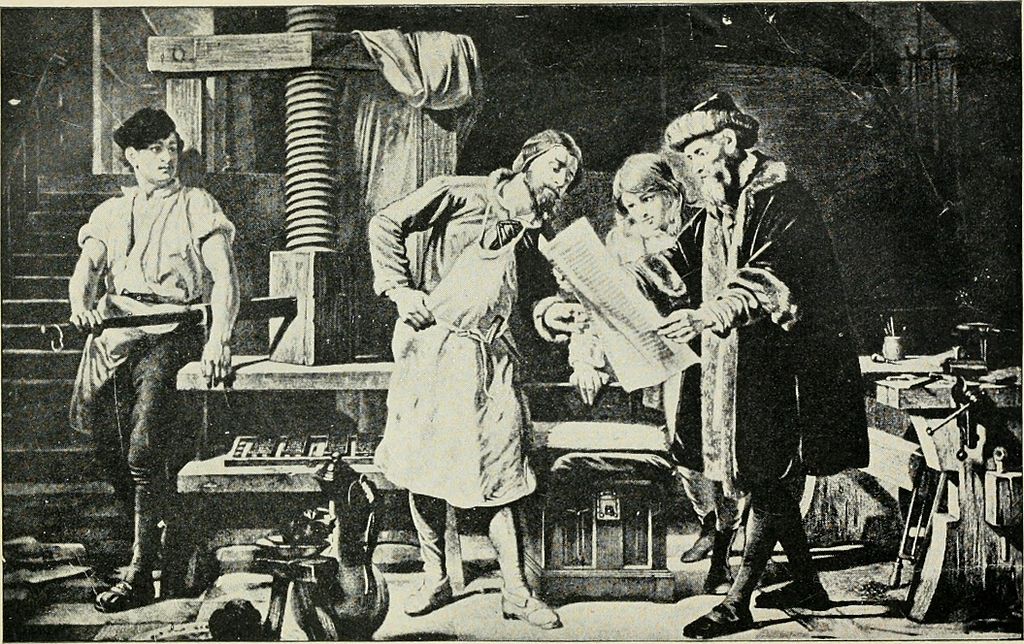
Gutenberg Printing Press; Image Courtesy of Wikipedia
Exploration
“In 1492, Columbus sailed the ocean blue” is a common way to remember the start of European exploration in the late 1400s. By searching for a route to Asia, to circumvent the Muslim world, Columbus “finding” the New World, or the Americas, changes human history in unprecedented ways, both positive➕ and negative➖. His exploration and later European explorers were enabled by new navigation and military technologies as well as improvements in cartography.
Cartography involves the creation of maps. Maps are essential parts of any form of exploration, and being able to create more detailed and accurate maps enabled explorers to piggy-back off one another to push further and further into the Americas. The increasing complexity of maps throughout this time period led many wealthy individuals to even display maps in their homes, alongside paintings, to showcase their extravagance and perceived intelligence.
Compass - Image Courtesy of Wikipedia
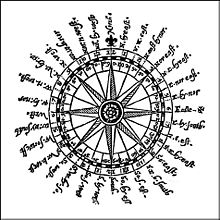
In addition to Cartography, navigational and military technological advances provided Europeans with the necessary advantages to explore, colonize, and establish their empires. The compass🧭 allowed Europeans greater understanding of the direction they were traveling (while in the middle of the ocean) by using the North and South poles magnetic field to pinpoint north, south, east, and west. The sternpost rudder gave ships greater maneuverability, and ship captains could ensure they were staying on course (guided by the compass) during long sea voyages.
Since the lands Europeans encountered were occupied, and with the European desire for exploitation, military technology, such as guns and gunpowder💣, which Native populations in the Americas did not have, gave Europeans the ability to conquer large empires, such as the Aztecs and Incas. Although disease helped Europeans in their conquest, guns and gunpowder were essential commodities for conquest.
c. 1648-1815
Context
As Europe transitioned into the 18th century, nations solidified across the continent as competition intensified. Primarily, this resulted in the transition from feudalism into sovereign and centralized nations. Feudalism is more associated with local rulers, but this era in Europe starts to combine local rulers into one larger kingdom. The other transition associated with political centralization is that it may not necessarily be associated with religion. Advances in technology led to more intense and bloodier warfare among these nations.
Warfare
In the previous era, advances in military technology, such as guns and gunpowder, were used primarily against non-Europeans. However, in this era, military innovations were used mostly against Europeans themselves. The mobile cannon💣, essentially a larger, more powerful, and more destructive version of a firearm, was used in infantry combat as well as to tear down fortification walls. These mobile cannons would even be put on ships for use in naval entanglements. Of course, warfare technology was expensive, thus nations that could collect taxation effectively among their constituents overpowered those nations that could not.
The Scientific Revolution🔬
Evolving from the Renaissance, the Scientific Revolution was the start of modern science in Europe, with an emphasis on the scientific method that stressed observation, data collection, forming hypotheses, and testing hypotheses. Thus, the scientific method was used by numerous Europeans to challenge existing ideas as well as create new ways to medically treat the human body. Francis Bacon and Rene Descartes promoted mathematics as a way to more accurately collect and analyze data related to the scientific method.
Image Courtesy of Ohio State University
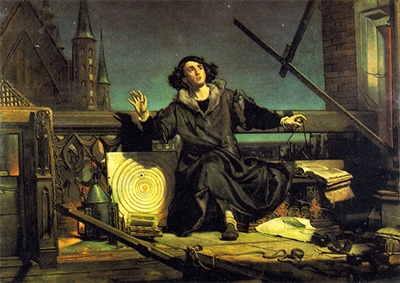
Bacon and Descartes went further through the use of inductive and deductive reasoning. Inductive reasoning involves the probability that something is true, and in deductive reasoning, the conclusions are almost certainly true in an experiment. This informs the scientific method in crucial ways by suggesting a great deal of evidence needs to exist in order to say definitively about an idea’s validity.
In astronomy, Copernicus, Galileo, and Newton developed new theories about the world, universe, and how everything worked. Copernicus proposed the earth revolved around the sun🌞, which challenged religious leaders that invoked Old Testament passages about the sun standing still. Galileo supported Copernicus's interpretation of the universe, stressing a heliocentric viewpoint (the sun, not earth, is the center). This greatly upset religious leaders that believed the earth was the center of the universe, even leading Galileo to being placed on house-arrest over his views.
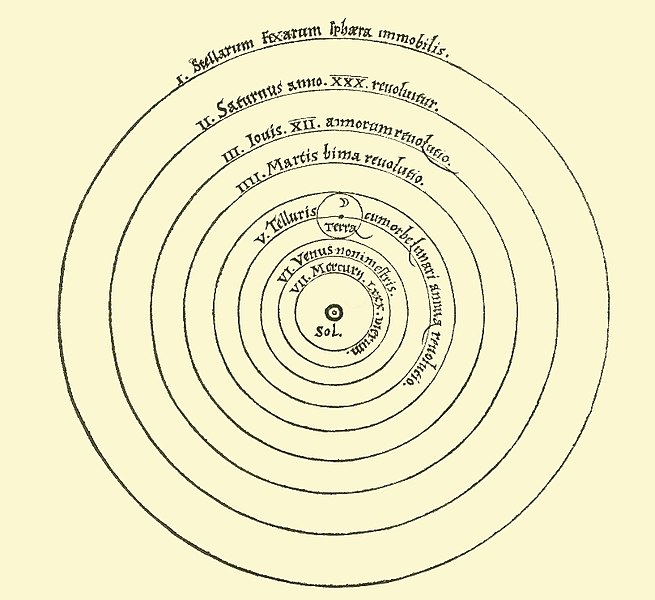
Copernicus’s Heliocentric Universe - Image courtesy of Wikimedia
A second challenge to tradition came from within the medical field. William Harvey did not believe an earlier physician from the Roman era, Galen, regarding the circulation of blood. Galen believed blood circulated on two one-way tracks in the body. William Harvey, however, challenged that idea by stating the human body had a unified blood circulation🩸, with the heart pumping blood to the brain and throughout the body.
Despite these challenges, some traditional views persisted, especially for wealthier individuals. Alchemy🧪 involved trying to change some metals into other metals as well as try to find ways to cure all illnesses, even old age. Astrology⭐ focused on studying the stars and how planetary movements influenced human lives. In both alchemy and astrology, scientific principles such as observation did not influence their conclusions. However, the idea of a predictable universe appealed to scientists and non-scientists alike.
c. 1815-1914
Context
The Industrial Revolution🏭 changed everything about human society. It changed where people lived, family dynamics, the environment, and the gap between rich💰 and poor💸. New technology and scientific innovations fueled this radical change in human society, and the consequences were both promising for the flourishing of humanity as well as deadly.
Industrialization
The Industrial Revolution is primarily about the shift from farming to factories. Factories involved humans and machines working together to create products cheaper and more efficiently. By the end of this era, the vast majority of production occurred through factories. Eli Whitney’s interchangeable parts helped propel factory production by creating ways to repair part of a machine without having to replace it entirely.
New transportation and communication technologies facilitated the growth of industrialization, the movement of people to cities, and the unifying of national economies. The railroad🚃 provided overland transportation of goods and people quickly and efficiently. The steamship transported goods and people across oceans and up rivers. Both the railroad and steamship utilized fossil fuels to harness the necessary energy for transportation. This caused more goods available, and people increased their consumption of goods.
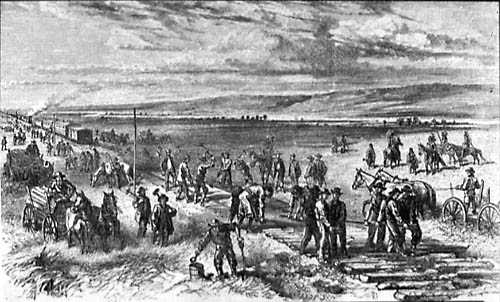
Building the Railroad - Image Courtesy of Wyoming Tales and Trails
Regarding communication, the telegraph allowed for messages to be transmitted within minutes across great distances via wiring. This is a great change compared with having to handwrite and deliver by hand a letter.
Using Progress for Personal Gain
Charles Darwin created the theory of Evolution, which states that species change over time, perhaps into more complex beings, and contains an element that the strong survive (“survival of the fittest”). In the late 1800s, Europeans used Darwin’s theory and applied it to human society and governments, known as Social Darwinism, to justify establishing colonies in Africa and Asia. The colonies existed to exploit the people economically as well as provided access for spreading Christianity.
In response to perhaps centuries of religious dominance in Europe, many philosophers turned to secular (non-religious) viewpoints. Positivism emphasized that science can provide the answers to all of humanity’s problems. However, some viewed science as not enough. Relativism pushed back on objective truth, and instead looked toward culture and individuals own perceptions for understanding.
Relativism pushed Europe toward modernity regarding knowledge by challenging existing understandings. Friedrich Nietzsche stated that “God is dead,” which meant that society is moving beyond religion. Psychology💭, the study of the human mind, behavior, and emotions, became popular through Sigmund Freud. Freud believed people were greatly influenced by a subconscious within their mind that caused them to behave in certain ways that people couldn’t necessarily control.
Einstein's Theory of Relativity challenged Newton’s ideas about the nature of the universe. The Theory of Relativity stated that places in the universe existed without gravity, which contradicts Newton’s idea that all things are influenced by a gravitational pull. That is a gross oversimplification of Einstein’s work, but it is important to remember these news ideas in the 19th century greatly changed European thought.
c. 1914- Present
Context
Byproducts of industrialization, imperialism, and competition for resources resulted in global struggles and war💣. Since 1914 and World War I, Europe and the rest of the world became more interconnected, with both positive and negative consequences. In this era, new inventions and scientific advancements🔬 will make life better and longer for humans while also being used to more efficiently kill one another, perhaps even ending humanity in general.
World War I
World War I was primarily fought in the trenches. Trench Warfare is essentially long ditches that housed troops separated by a field of battle called no-man’s land. This was a new fighting technique, and it caused for not a lot of territory to be gained or lost during the course of the war. For more on Trench Warfare, there’s a pretty cool scene in Wonder Woman (2017) that has trenches in it.
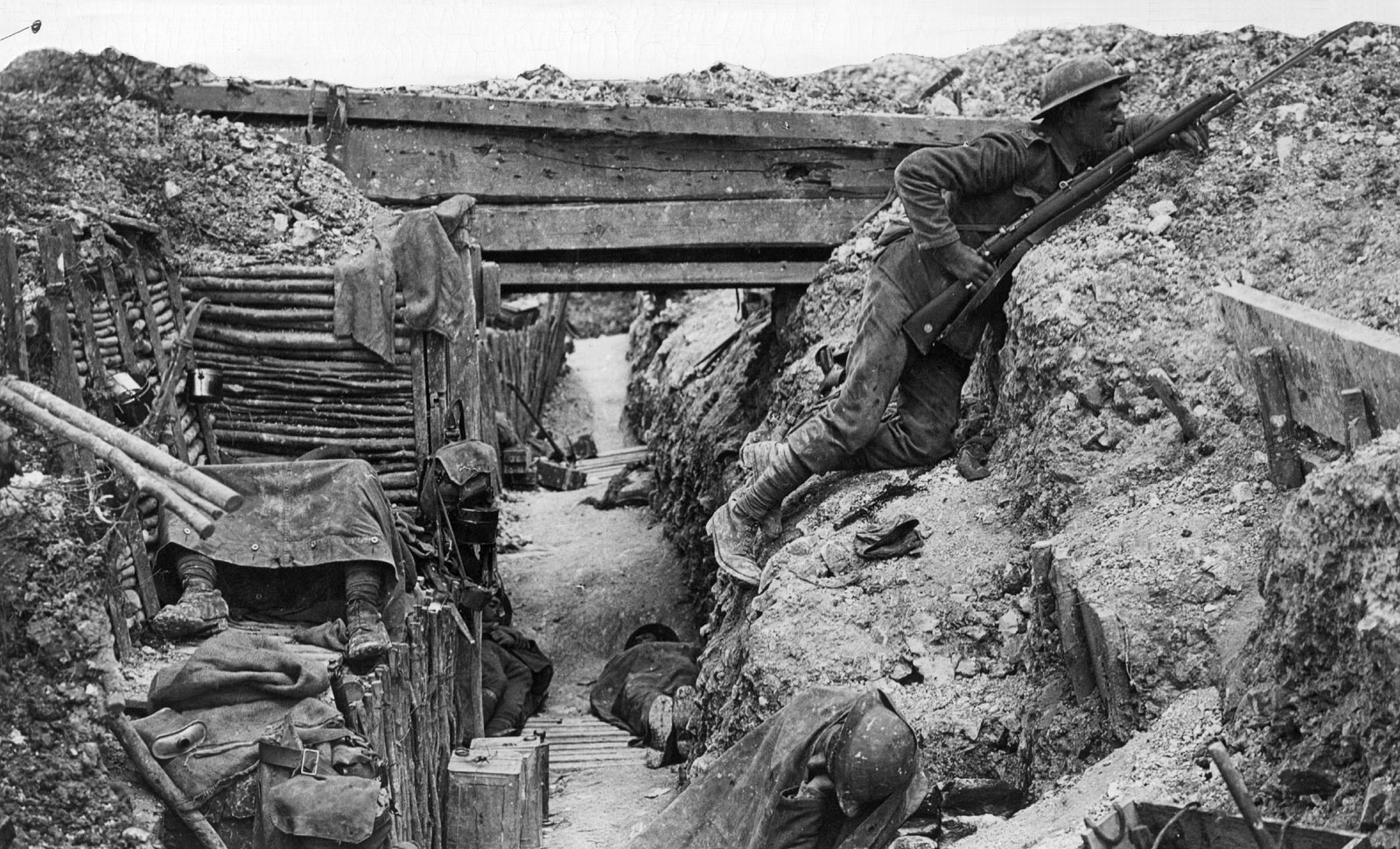
Trench Warfare - Image Courtesy of Britannica
New technologies utilized in World War I led to massive loss of life. The advances of science used against each other is a tragedy. The machine gun, poison gas, tank, and submarine are a few examples of the new technology used to kill one another in World War I.
World War II
Similar to World War I, new technology and new military techniques led to increased loss of human life. Germany’s new military technique, known as Blitzkrieg, or “lighting war,” allowed them to rapidly advance their forces by using faster tanks, air support from planes, and focusing their forces on specific points instead of spreading them out. Germany used this to quickly conquer Poland in 1939 (which led Great Britain and France to declare war) and France in 1940.
The U.S. eventually enters the war, bringing with it superior industrialized power that eventually overwhelmed Germany and Japan. To bring Japan to surrender, the U.S. developed the nuclear bomb💣 that could destroy an entire city. The U.S. used the nuclear bomb on two Japanese cities before their ultimate surrender. This increased fear and tension in the world because humanity could literally destroy itself through nuclear weapons.
Nuclear Impact on Hiroshima, Japan - Image Courtesy of Time Magazine

Ethical Debates
New technology from 1914 to the present influenced debates regarding morality, religion, and philosophy. Birth control and abortion related to women’s bodies and feminism, however, not everyone supported these practices. Birth control💊, especially in the 21st century, involves taking a pill that helps prevent a woman from becoming pregnant, and abortion terminates an unwanted pregnancy. Abortion occurs for a variety of reasons (sometimes to even protect the health of the woman), but it sparks debate, particularly from religious groups, about the ethical nature of the practice.
Globalization🌍
Globalization makes the world, including Europe, more interconnected. Ideas, goods, and technology travel from one country to another rapidly. Europe experienced a great deal of imported technology from the U.S. following the end of World War II in 1945.
New communication technology transformed European life, such as telephone📞, radio📻, television📺, and the internet💻. Ideas could be spread quicker than ever before in history, and people, especially with the internet, could participate in contemporary debates with one another. With television and the internet, people in Europe would recognize and appreciate celebrities that perhaps never set foot in Europe.
Not everyone appreciated globalization because of its impact on the environment and the nature of consumerism. Serious environmental issues persist in Europe, especially regarding greenhouse gases and climate change. That is a byproduct of industrialization and magnified with globalization. These Green party groups desire for more sustainability and not the destruction of the natural world.
Sample Questions
Sample SAQ for this Theme:
Answer (a), (b), and (c).
- Identify and explain a new technology or innovation that contributed to European colonization from 1450-1648.
- Identify and explain a second new technology or innovation that contributed to European colonization from 1450-1648.
- Identify and explain a third new technology or innovation that contributed to European colonization from 1450-1648.
Sample LEQ for this Theme:
To what extent did new technology foster change in European society from 1945 to the present?
Browse Study Guides By Unit
🎨Unit 1 – Renaissance & Exploration
⛪️Unit 2 – Reformation
👑Unit 3 – Absolutism & Constitutionalism
🤔Unit 4 – Scientific, Philosophical, & Political Developments
🥖Unit 5 – Conflict, Crisis, & Reaction in the Late 18th Century
🚂Unit 6 – Industrialization & Its Effects
✊Unit 7 – 19th Century Perspectives & Political Developments
💣Unit 8 – 20th Century Global Conflicts
🥶Unit 9 – Cold War & Contemporary Europe
📚Study Tools
🤔Exam Skills
👉Subject Guides

Fiveable
Resources
© 2025 Fiveable Inc. All rights reserved.